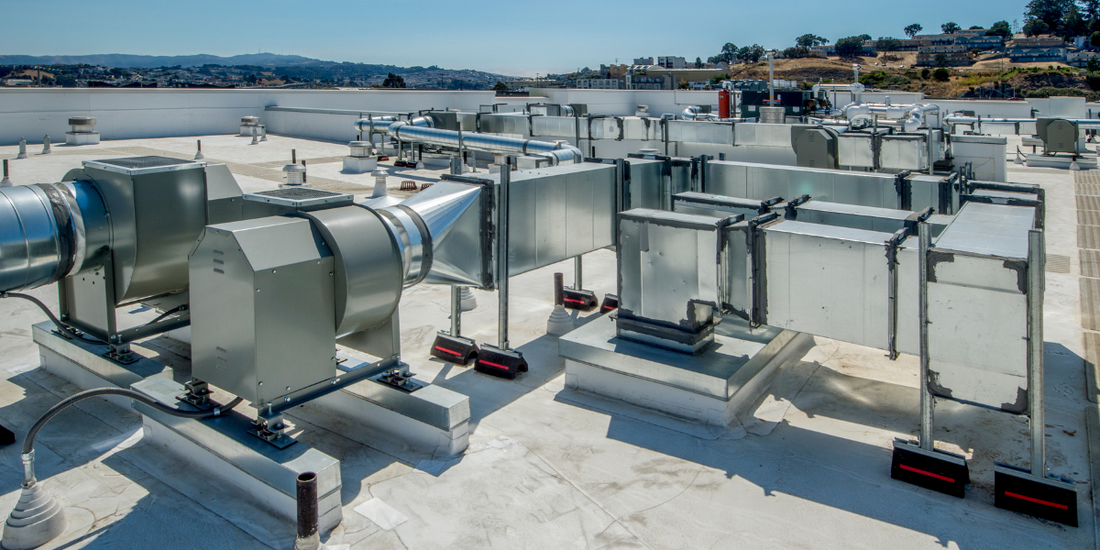
Why Commercial ERVs and HRVs Are Essential for Modern Building Ventilation
Share
Fresh Air, Lower Energy Costs, and Code Compliance - All in One Commercial Ventilation System
In today’s commercial construction environment, proper ventilation is no longer optional - it’s required. As energy efficiency codes tighten and indoor air quality (IAQ) becomes a primary concern, Commercial ERVs (Energy Recovery Ventilators) and Commercial HRVs (Heat Recovery Ventilators) have become essential for medium to large-scale buildings.
Whether you're a facility manager focused on tenant comfort, an HVAC contractor installing systems across multiple zones, or a design-build firm planning your next LEED-certified project, understanding the benefits of Commercial ERVs and HRVs can save time, money, and ensure compliance.
What Are Commercial ERVs and HRVs?
Commercial ERVs and Commercial HRVs are high-performance ventilation systems designed to recover energy from exhausted indoor air and use it to condition incoming outdoor air. Unlike basic exhaust-only or supply-only systems, these units provide balanced ventilation, reducing the load on heating and cooling equipment while maintaining proper building pressure.
- Commercial ERVs transfer both heat and moisture (ideal for mixed or humid climates).
- Commercial HRVs transfer only heat energy (best for cold, dry regions).
Most Commercial ERV/HRV units range from 250 CFM to 3000+ CFM and are designed for rooftop, ceiling, or wall-mounted installations.
Top 5 Benefits of Commercial ERVs and HRVs
1. Improved Indoor Air Quality (IAQ)
Poor indoor air quality is linked to headaches, fatigue, and long-term health issues. Commercial ERVs and HRVs continuously supply fresh outdoor air while exhausting stale indoor air, reducing:
- CO₂ buildup
- Volatile Organic Compounds (VOCs)
- Odors and airborne pathogens
Many systems now include MERV 13-15 filters or HEPA-ready cabinets to meet ASHRAE 241 guidelines for airborne pathogen control in non-healthcare buildings.
2. Significant Energy Savings
Conditioning outdoor air is one of the largest energy expenses in commercial buildings. Commercial ERVs and HRVs can recover 60%-90% of heating and cooling energy, reducing HVAC operating costs and improving ROI.
Example: In colder climates, a Commercial HRV can reclaim up to 70% of heating energy during winter months-saving thousands annually for high-capacity systems.
Energy recovery is now required by many codes, including ASHRAE 90.1, IECC, and Title 24, making these systems a smart, compliant choice.
3. Guaranteed Code Compliance
Commercial ERVs and HRVs help meet major ventilation and energy codes:
- ASHRAE 62.1 (minimum ventilation rates)
- ASHRAE 90.1 (energy efficiency)
- IECC / Title 24 (mechanical ventilation requirements)
Advanced models offer CO₂ sensors, demand-controlled ventilation, and airflow monitoring for automated adjustments, ensuring compliance and efficiency.
4. Seamless Integration with Building Systems
Modern Commercial ERV/HRV units integrate easily with BMS platforms and HVAC systems. Key features include:
- BACnet or Modbus compatibility
- EC motors with variable speed control
- Bypass dampers for economizer mode
- Sensor inputs for temperature, CO₂, and humidity
- Optional pre-heat coils (electric or hydronic)
This level of control optimizes ventilation for multiple zones, reduces energy costs, and improves occupant comfort.
5. Scalable Solutions for All Commercial Applications
Commercial ERVs and HRVs are ideal for:
- Schools and universities (high occupancy, seasonal schedules)
- Healthcare and senior care facilities (stringent air quality requirements)
- Restaurants and retail (odor and humidity management)
- Multifamily housing (balanced airflow between units)
- Warehouses and industrial spaces (dust and fresh air control)
Advanced configurations include counterflow enthalpy cores, frost-resistant designs, and modular layouts for tight mechanical spaces or rooftops.
Installation Best Practices for Maximum Efficiency
Proper installation is critical to ensure Commercial ERV/HRV systems operate at peak performance.
Guidelines:
- Duct Design: Minimize bends and transitions to reduce static pressure.
- Balance Airflow: Maintain equal supply and exhaust rates to avoid pressure issues.
- Access: Allow for filter changes and core cleaning.
- Commissioning: Confirm airflow, sensor calibration, and defrost cycle function at startup.
Note: ERVs reduce humidity load in mixed or warm climates, while HRVs include frost protection cycles for extreme cold environments.
Why Builders and Facility Managers Choose Commercial ERVs and HRVs
The shift to electrification, tighter building envelopes, and post-pandemic IAQ priorities makes Commercial ERVs and HRVs essential. These systems help builders:
- Earn LEED or WELL certifications
- Qualify for energy efficiency rebates
- Meet evolving ventilation and energy codes
Facility managers benefit from lower HVAC maintenance costs and improved occupant satisfaction in mission-critical buildings.
Conclusion: A Smart Investment for Long-Term Performance
Commercial ERVs and HRVs offer unmatched energy efficiency, superior IAQ, and guaranteed code compliance. As ventilation standards continue to evolve, these systems will remain a key part of sustainable building strategies.
Need Help Choosing the Right Commercial ERV or HRV?
Whether you're upgrading an existing system or designing a high-performance facility, our team can help you select, size, and specify the right solution. Contact us today via phone or email for engineering support, submittals, or project quotes.
